Suzuki Solio – Wikipedia
From Wikipedia, the free encyclopedia
Minivan built by Suzuki
Motor vehicle
The Suzuki Solio (Japanese: スズキ・ソリオ, Suzuki Sorio) is a mini MPV manufactured and marketed by Suzuki since 1997. The preceding model and the first generation Solio were derived from the narrower Wagon R.
Predecessor: Wagon R-Wide (MA61S/MB61S; 1997)[edit]
Motor vehicle
| Suzuki Wagon R-Wide (MA61S/MB61S) | |
|---|---|
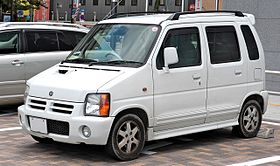
Suzuki Wagon R-Wide (pre-facelift, Japan) |
|
| Also called | |
| Production |
|
| Assembly | Japan: Sagara Plant, Shizuoka Prefecture China: Jiangxi, China Colombia: Bogotá (GM Colmotores) Indonesia: Bekasi Regency (SIM) |
| Class | City car/Mini MPV |
| Body style | 5-door hatchback |
| Layout | Front-engine, front-wheel-drive or four-wheel-drive |
| Related | Suzuki Wagon R (first generation) |
| Engine | |
| Transmission | 4-speed automatic 5-speed manual |
| Wheelbase | 2,355 mm (92.7 in) |
| Length | 3,400–3,470 mm (133.9–136.6 in) |
| Width | 1,575 mm (62.0 in) |
| Height | 1,670–1,705 mm (65.7–67.1 in) |
| Curb weight | 810–880 kg (1,786–1,940 lb) |
| Successor | Suzuki Karimun Estilo (Indonesia) |
The predecessor to the Solio, the Wagon R-Wide, was introduced in February 1997, as a slightly larger version of the Wagon R, exceeding the kei car specifications, with larger engines of 1 or 1.2 liters. The Wagon R-Wide was sold as the Wagon R+ in the European market (also introduced in the same year) with the atmospheric versions of the 1.0 K10A and the 1.2 K12A. The only other tall wagon style car sold in Europe around the time of its introduction was the Daihatsu Move. The car was made in Japan. It was not galvanised and it was prone to rust, especially in the sills, after years of use in Central and Northern Europe. The Wagon R-Wide was slightly facelifted in May 1998, and this updated Wagon R-Wide was also sold in Europe under Wagon R+. In Europe, the first-generation Wagon R+ was sold from 1997 until May 2000.
The engines were the 996 cc K10A, in naturally aspirated or turbocharged forms, or the later 1171 cc naturally aspirated K12A. The naturally aspirated K10A produces 65 PS (48 kW) and 88 Nm. The turbocharged version was only available in Japan, New Zealand, and Australia; it puts out 100 PS (74 kW) and 118 Nm. The 1.2-litre K12A engine produces 70 PS (51 kW) and 93 Nm. The larger engine was the only one offered in conjunction with four-wheel drive in Europe.
Between 1999 and 2001, it was also built in Colombia by GM Colmotores, who sold it as the Chevrolet Wagon R+.[1] This was equipped with the naturally aspirated K10A four-cylinder engine.[2]
In Indonesia, the facelifted Japanese Wagon R-Wide was sold as the Suzuki Karimun[3] and was produced locally from 1999 until 2006 and offered with a 1.0-liter petrol engine, whilst in China it forms the base for Changhe Beidouxing. The Big Dipper is available with an indigenously built 1.0-liter engine based on the old F10A, or with the more modern 1.4-liter K14B engine.[4]
-
Suzuki Wagon R-Wide (pre-facelift, Japan)
-

Suzuki Wagon R-Wide (facelift, Japan)
-
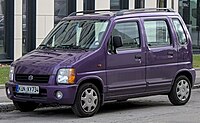
Suzuki Wagon R+ (facelift, Germany)
-

Suzuki Wagon R+ (facelift, Germany)
-

Suzuki Karimun GX (Indonesia)
-

Suzuki Karimun GX (Indonesia)
First generation (MA63S/MA64S/MA32S; 1999)[edit]
Motor vehicle
| First generation (MA63S/MA64S/MA34S) | |
|---|---|

2003 Suzuki Wagon R+ GL 1.3 (pre-facelift, UK) |
|
| Also called |
|
| Production | 1999–2010 |
| Assembly | |
| Engine | |
| Transmission | |
| Wheelbase | 2,360 mm (92.9 in) |
| Length | 3,545 mm (139.6 in) |
| Width | 1,620 mm (63.8 in) |
| Height | 1,665–1,705 mm (65.6–67.1 in) |
| Curb weight | 970 kg (2,138 lb) |
| Successor | Suzuki Splash (outside Japan) |
The Wagon R+ was launched in May 1999 in Japan, replacing the Wagon R-Wide. This updated version started sales in the European market in the summer of 2000. The main difference between the JDM Wagon R+ and the European Wagon R+ is the door handles, which on JDM models were body-colored while European models received black door handles.
In December 2000, the Japanese-spec model was renamed Wagon R Solio, and this was available both in the bottom-of-the-line X trim level and in a more sports-oriented trim level known as the 1.3. In June 2002, the 1.0 E trim level was added to the Wagon R-Solio lineup. In August 2003, a mid-facelift Wagon R-Solio was released. In April 2004, the Wagon R-Solio was renamed Solio, losing the Wagon R moniker entirely. In August 2005, a facelifted Solio was launched.
The Hungarian-built Wagon R+ is still being produced for the European market (in 2008, Wagon R-Solio and Solio are not sold), albeit with limited range and availability (it is no longer for sale in Ireland, for example). As of 2006 in the UK, only one model is available – the GL, with a 1.3 litre (1298 cc) 16 valve 4-cylinder petrol engine delivering 59 kW (80 PS; 79 hp), ABS with EBD and air conditioning as options. The current model is 3,540 mm (139.4 in) x 1,620 mm (63.8 in) x 1,695 mm (66.7 in) (length x width x height), with a claimed 597 litres (21.1 cu ft) of cargo space. It was too difficult for either the Wagon R-Solio or Solio to meet with Euro NCAP crash safety ratings. As a result, the Wagon R+ continued in Europe until late 2008, when replaced by the Splash.
From 2000 until 2007, the Wagon R+ is rebadged as Opel/Vauxhall Agila. The Agila was built at an Opel factory in Gliwice, Poland and used Opel Engines and transmissions. The last Agila was a rebadged Splash.
-

2003 Suzuki Wagon R+ GL 1.3 (pre-facelift, UK)
-
Suzuki Wagon R+ DDiS 1.3 (facelift, Italy)
-

2002–2005 Suzuki Wagon R Solio (first facelift, Japan)
-

2005–2010 Suzuki Solio (second facelift, Japan)
-

2005–2010 Suzuki Solio (second facelift, Japan)
-

Chevrolet MW (pre-facelift, Japan)
-

Chevrolet MW (pre-facelift, Japan)
-

Chevrolet MW (facelift, Japan)
-

Chevrolet MW (facelift, Japan)
-

Second generation (MA15S; 2010)[edit]
Motor vehicle
While the kei-version of the Wagon R went through third and fourth generations, the wider Solio remained in its first-generation until undergoing a full model change in December 2010. The second-generation Solio was released on 7 January 2011 and is based on the Palette instead of the Wagon R, although the Palette itself uses the Wagon R’s platform. This generation of Solio (MA15) also provides the basis for an OEM deal with Mitsubishi Motors, rebadged as the Mitsubishi Delica D:2, which was released in March 2011.[6] In Japan, it was sold at a specific retail chain called Car Plaza.
-
2011–2013 Suzuki Solio G
-

2011–2013 Suzuki Solio X
-

2011–2013 Suzuki Solio X
-
2011–2013 Suzuki Solio S
-
2011–2013 Suzuki Solio S
-
2012–2015 Suzuki Solio Bandit
-
2012–2015 Suzuki Solio Bandit
-
2013–2015 Suzuki Solio G
-
2013–2015 Suzuki Solio G
-
2011–2013 Mitsubishi Delica D:2 S
-
2013–2015 Mitsubishi Delica D:2 S
-
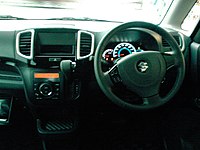
Third generation (MA26S/MA36S/MA46S; 2015)[edit]
Motor vehicle
The third-generation Solio was released in Japan on 26 August 2015.
-

-

-

Suzuki Solio Bandit Hybrid SV
-
Suzuki Solio Bandit Hybrid MV
-

-

-
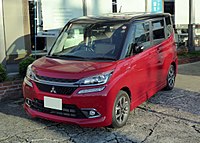
Mitsubishi Delica D:2 Custom
-

Fourth generation (MA27S/MA37S; 2020)[edit]
Motor vehicle
| Fourth generation (MA27S/MA37S) | |
|---|---|
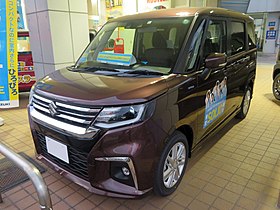
2020 Suzuki Solio Hybrid MZ |
|
| Also called | Mitsubishi Delica D:2 |
| Production | 2020–present |
| Assembly | Japan: Makinohara, Shizuoka (Sagara plant) |
| Platform | HEARTECT platform |
| Engine | 1242 cc K12C DOHC VVT Dualjet I4 |
| Electric motor | WA05A (MHEV) |
| Transmission | CVT |
| Wheelbase | 2,480 mm (97.6 in) |
| Length | 3,790 mm (149.2 in) |
| Width | 1,645 mm (64.8 in) |
| Height | 1,745 mm (68.7 in) |
| Curb weight | 960–1,000 kg (2,116–2,205 lb) 1,000–1,040 kg (2,205–2,293 lb) (hybrid) |
The fourth-generation Solio was released in Japan on 25 November 2020.[7]
-

-

2020 Suzuki Solio Bandit Hybrid MV
-

-

2021 Mitsubishi Delica D:2 Hybrid MZ 4WD (MB37S)
-
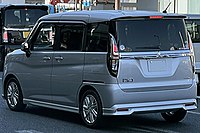
2021 Mitsubishi Delica D:2 Hybrid MZ 2WD (MB37S)
-

2021 Mitsubishi Delica D:2 Custom Hybrid MV 2WD (MB37S)
-

Mitsubishi Delica D:2 interior
References[edit]
External links[edit]

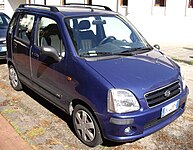


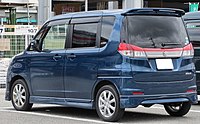
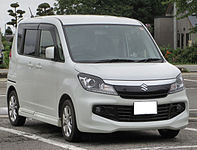
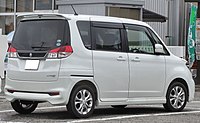





Recent Comments